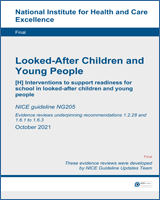From: Interventions to support readiness for school in looked-after children and young people

NCBI Bookshelf. A service of the National Library of Medicine, National Institutes of Health.
| Study (country) | LACYP population | Intervention | Comparator | Number of patients who completed study | Outcomes reported (follow up f/u) |
|---|---|---|---|---|---|
| Preschool interventions | |||||
| Bernard 2017 (USA) | Children in foster care (infant aged) | Attachment and biobehavioural catch up for infants (ABC-I) | Developmental Education for Families (DEF) |
ABC-I: 24 DEF: 28 | Receptive language score (at 3 years of age) |
| Lind 2017 (USA) | Children living in foster care (age at intervention approximately 2.5 years) | Attachment and biobehavioural catch up for toddlers (ABC-T) | DEF |
ABC-T: 63 DEF: 58 |
Attention problems score (approximately 2 year f/u) Cognitive flexibility (approximately 2-year f/u) |
| Lipscomb 2013 (USA) | Children living with non-biological parents or in kinship care (aged 3–4 years) | Head Start (HS) programme | CAU |
HS: 154 CAU: 99 | Pre-academic skills (1-year follow up) externalising behavior problems (1-year follow up) Teacherchild relationship (1-year follow up) |
| Raby 2019 (USA) | Children living in foster care (age 2 – 3 years) | ABC-T | DEF |
ABC-T: 45 DEF: 43 | Receptive vocabulary (composite score over 2 years follow up) |
| Lewis-Morrarty 2012 (USA)1 | Children living in foster care (intervention delivered prior to age 20 months) | Attachment and biobehavioural catch up for infants and toddlers (ABC-I/T) | DEF |
ABC-I: 17 DEF: 20 |
Cognitive flexibility (at 4–6 years) Theory of mind (at 4–6 years) |
| Lee 2016a, Lee 2016b, (USA) | Children living with non-biological parents or in kinship care (aged 3–4 years) | HS | CAU |
HS: 97 CAU: 65 |
Maths score (at age 5 – 6) Reading score (at age 5 – 6) |
| Entering primary school-age education | |||||
| Pears 2007 (USA) | Children living in foster care entering second grade (age 7–8) from kindergarten | Therapeutic playgroups (TP) | CAU |
TP: 10 CAU: 10 |
Foster parent rated social competence and behavioural functioning (2 week f/u) Foster parent rated emotional regulation and lability (2-week f/u) Assessor-rated emotional lability (2-week f/u) Teacher-rated emotional regulation and lability score (f/u 1 month following the start of school) |
|
Pears 2012 (USA) | Children living in foster care entering kindergarten (age 5–6) | Kids in Transition to School (KITS) programme | CAU |
KITS: 102 CAU: 90 |
Initial sound fluency; Letter naming fluency; Concepts about print; Caregiver rating of pre-reading skills; preschool PIPPS score, CBCL social competence; Emotional understanding; inhibitory control; behavioural regulation; emotional regulation (end of summer prior to kindergarten, following intervention) Teacher-reported aggressive behaviour; Teacher-reported delinquent behaviour; Teacher-reported oppositional behaviour (measured end of kindergarten year) Days free from internalising symptoms; days free from externalising symptoms (over 12 months of kindergarten) Positive attitudes towards alcohol; positive attitudes towards antisocial behaviours; involvement with deviant peers; self-competence (measured third grade – 9 years old) |
| Entering secondary school-age education | |||||
| Kim 2011, Smith 2011, (USA) | Girls in foster care, in final year of elementary school (mean age approximately 11.5 years) | Middle School Success (MSS) | Care as usual (CAU) |
MSS: 48 CAU: 52 |
Internalising and externalising symptoms score (24-month f/u) Prosocial behaviour score (12-month f/u) Delinquent behaviour (36 months) Association with delinquent peers (36 months) Substance use (36 months) |
Part of a three-armed trial including a non-foster community comparison group
From: Interventions to support readiness for school in looked-after children and young people

NCBI Bookshelf. A service of the National Library of Medicine, National Institutes of Health.